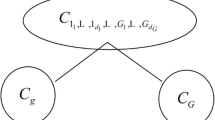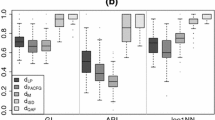Abstract
A model-based clustering method for cross-sectional time series data is proposed and applied to crop insurance programs. To design an effective grouprisk plan, an important step is to group together the farms that resemble each other and decide the number of clusters, both of which can be achieved via the model-based clustering. The mixture maximum likelihood is employed for inferences. However, with the presence of correlation and missing values, the exact maximum likelihood estimators (MLEs) are difficult to obtain. An approach for obtaining approximate MLEs is proposed and evaluated through simulation studies. A bootstrapping method is used to choose the number of components in the mixture model.
Similar content being viewed by others
References
Banfield, J. D., and Raftery, A. E. (1993), “Model-Based Gaussian and Non-Gaussian Clustering,” Biometrics, 49, 803–821.
Bozdogan, H. (1993), “Choosing the Number of Component Clusters in the Mixture-Model Using a New Information Complexity Criterion of the Inverse-Fisher Information Matrix,” in Studies in Classification. Data Analysis, and Knowledge Organization, eds. O. Opitz, B. Lausen, and R. Klar, Heidelberg: Springer-Verlag, pp. 40–54.
Bozdogan, H., and Scolve, S. L. (1984), “Multi-Sample Cluster Analysis Using Akaike’s Information Criterion,” Ann. Inst. Statist. Math., 36, 163–180.
Bryant, P., and Williamson, J. A. (1978), “Asymptotic Behavior of Classification Maximum Likelihood Estimates,” Biometrika, 65, 272–281.
Chen, J., and Cheng, P. (1997), “On Testing the Number of Components in Finite Mixture Models With Known Relevant Component Distributions,” Canadian Journal of Statistics, 25, 389–400.
Dacunha-Castelle, D., and Gassiat, E. (1997), “The Estimation of the Order of a Mixture Model,” Bernoulli, 3, 279–299.
Everitt, B. S., and Hand, D. J. (1981), Finite Mixture Distributions, London: Chapman and Hall.
Feng, Z. Z., and McCulloch, C. E. (1996), “Using Bootstrap Likelihood Ratios in Finite Mixture Models,” Journal of the Royal Statistical Society, Series B, 58, 609–617.
Friedman, H. P., and Rubin, J. (1967), “On Some Invariant Criterion for Grouping,” Journal of the American Statistical Association, 62, 1159–1178.
Gordon, A. D. (1981), Classification: Methods for the Exploratory Analysis of Multivariate Data, New York: Chapman and Hall.
Hartigan, J. A. (1985), “A Failure of Likelihood Asymptotic for Normal Mixtures,” in Proceedings of the Berkeley Conference in Honor of Jerzy Neyman and Jack Kiefer (Vol. II), ed. L. LeCam and R. A. Olshen, Belmont, CA: Wadsworth and Brooks, pp. 807–810.
Hennessy, D. A., Babcock, B. A., and Hayes, D. J. (1997), “Budgetary and Producer Welfare Effects of Revenue Insurance,” American Journal of Agricultural Economics, 79, 1024–1034.
McLachlan, G. J. (1982), “The Classification and Mixture Maximum Likelihood Approaches to Cluster Analysis,” in Handbook of Statistics (Vol. 2), eds. P. R. Krishnaiah and L. N. Kanal, Amsterdam: North-Holland, pp. 199–208.
— (1982), “On Bootstrapping the Likelihood Ratio Test Statistic for the Number of Components in Normal Mixture,” Applied Statistics, 36, 318–324.
McLachlan, G. L., and Basford, K. E. (1988), “Maximum Models: Inferences and Applications to Clustering. New York: Marcel Dekker.
Marriott, F. H. C. (1975), “Separating Mixtures of Normal Distributions,” Biometrics, 31, 767–769.
Nelson, C. H. (1991), “The Influence of Distributional Assumption on the Calculation of Crop Insurance Premia,” North Central Journal of Agricultural Economics, 12, 71–78.
Redner, R. A., and Walker, H. F. (1984), “Mixture Densities, Maximum Likelihood and the EM Algorithm,” SIAM Reviews, 26, 195–239.
Roeder, K. (1994), “A Graphical Technique for Determining the Number of Components in a Mixture of Normals,” Journal of the American Statistical Association, 89, 487–495.
Scolve, S. L. (1983), “Application of the Conditional Population-Mixture Model to Image Segmentation,” IEEE Transactions an Pattern Analysis and Machine Intelligence, 5, 428–433.
Symons, M. (1981), “Clustering Criteria and Multivariate Normal Mixtures,” Biometrics, 37, 35–43.
Titterington, D. M. (1990), “Some Recent Research on the Analysis of Mixture Distributions,” Statistics, 21, 619–641.
Titterington, D. M., Smith, A. F. M., and Makov, U. E. (1985), Statistical Analysis of Finite Mixture Distributions. London: Wiley.
Wang, H. H., Hanson, S. D., Myers, R. J., and Black, J. R. (1998), “The Effects of Yield Insurance Designs on Farmer Participation and Welfare,” American Journal of Agricultural Economics, 80, 806–820.
U.S. Department of Agriculture. (1978), “Palouse Cooperative River Basin Study”, in Cooperative Study by Soil Conservation Service, Forest Service, and Economics, Statistics, and Cooperatives Service of Whitman Couty, WA, Washington, DC: U.S. Government Printing Office.
U.S. General Accounting Office. (1995), “Crop Insurance Additional Actions Could Further Improve Programs’s Financial Condition,” im Report to the Ranking Minority Member, Committee on Agriculture, Nutrition, and Forestry, U.S. Senate GAO/RCED-95-269, Washington, DC: Government Printing Office.
Author information
Authors and Affiliations
Rights and permissions
About this article
Cite this article
Wang, H.H., Zhang, H. Model-Based clustering for cross-sectional time series data. JABES 7, 107–127 (2002). https://doi.org/10.1198/108571102317475099
Received:
Accepted:
Issue Date:
DOI: https://doi.org/10.1198/108571102317475099




